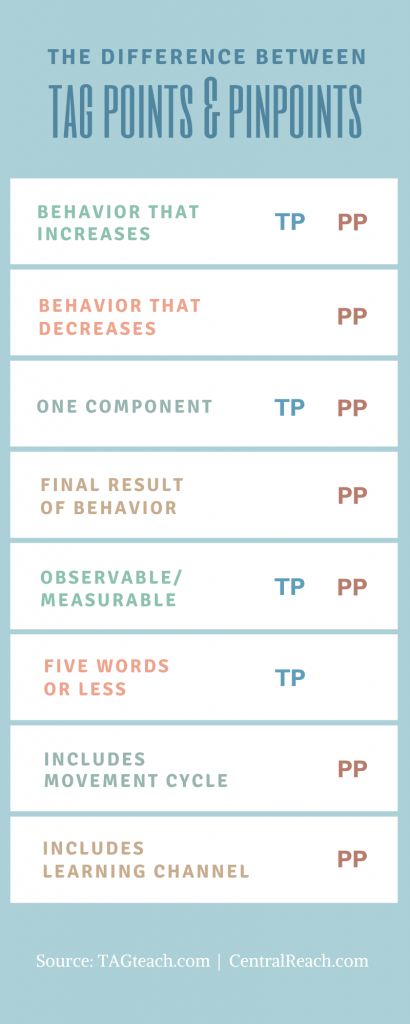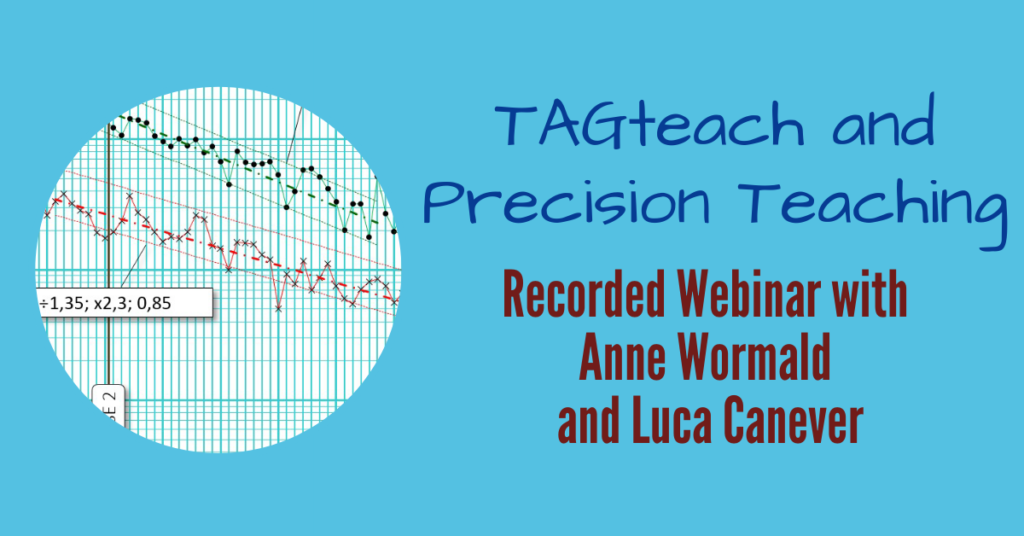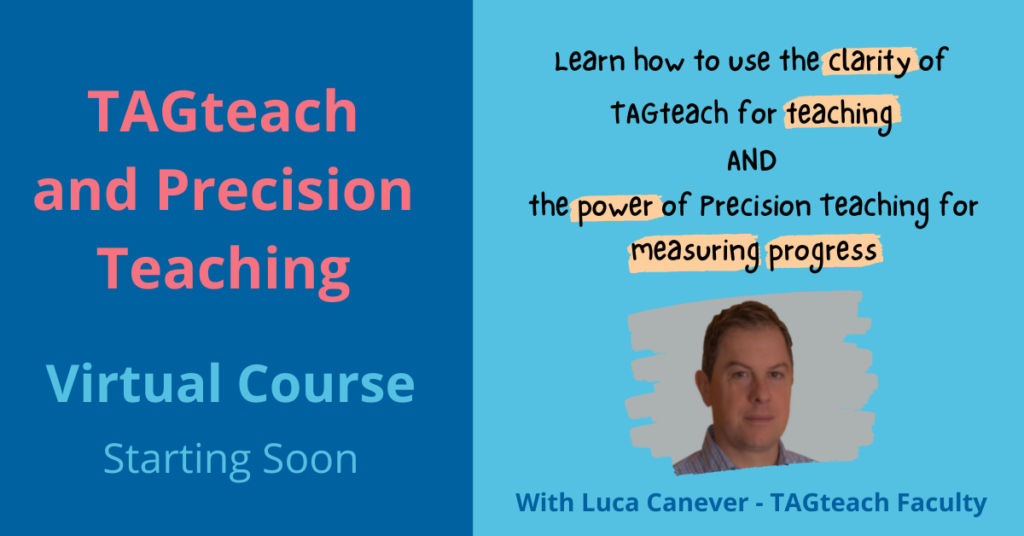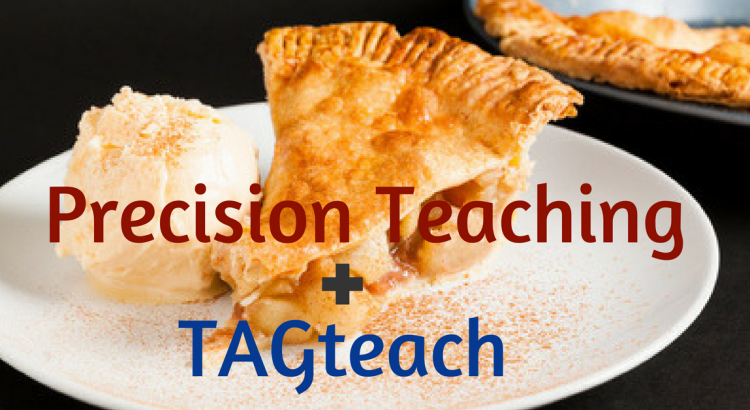By Joan Orr M.Sc. and Anne Wormald M.ADS, BCBA
TAGteach and Precision Teaching go together like ice cream and apple pie. Each makes the other even more awesome. Add TAGteach to your Precision Teaching and watch your acceleration lines soar. Add Precision Teaching to your TAGteaching and you’ll see exactly what’s working and what tag points are the most effective.
If you’re a TAGteacher and you’re wondering “what’s Precision Teaching”, watch Amy Evans of Octave Consulting explain it in 11 minutes:
If you’re a Precision Teacher and you’re wondering “what’s TAGteach?”, visit TAGteach Online Learning for a free course: A+ Tag Point – How to Create a Perfect Learning Goal and additional paid courses.
What’s a Tag Point?
A tag point is the goal behavior in a TAGteach session. The teacher tags (marks) the desired behavior with a click sound (tag) when the behavior occurs so the learner knows the exact moment that they got it right. A tag point has four criteria (WOOF):
What you want: the tag point must be phrased in positive terms
One thing: the tag point can be only one behavior
Observable: the tag point must be observable
Five words or less: you must be able to articulate the tag point in five words or less
Read more about the WOOF criteria for tag points here.
What’s a Pinpoint?
A pinpoint is the behavior that will be counted in a Precision Teaching session. A pinpoint has the following criteria:
It must be an active behavior (a dead man can’t do it)
It must be an observable behavior
It must be a measurable (countable) behavior
It involves a movement cycle (description of the behavior and the object receiving the behavior)
It involves a learning channel (a linked unit of a sensory input and a behavioral output; e.g. see/do or hear/do)
Generating a pinpoint gives you a significantly better way to detect behavior. The precise description of the behavior you want to count is described in the pinpoint. If the behavior increases, decreases or stays the same as a result of your intervention you will be able to see this right away in the chart that you generate from your data on pinpoint counting.
Read more about how to generate a pinpoint .
What’s the Difference Between a Tag Point and a Pinpoint?
When TAGteach and Precision Teaching are used together, the most common way to do this is to use TAGteach for the teaching part and Precision Teaching for the measurement part. So you might teach a skill or part of a skill with tag points and then do a measurement probe to see what’s happening with your pinpoint.
Tag points are for actively teaching, but they don’t necessarily involve measurement. Pinpoints are observational. You’re not necessarily trying to teach a pinpoint, you’re just counting to see if your intervention is affecting the pinpoint rate of occurrence.
Sometimes a tag point and a pinpoint can be essentially the same. For example if you are trying to teach a child to hit a baseball off a t-ball stand, the tag point could be “shifts weight to inside foot” and the pinpoint could be “feel – do – shifts weight”. In this case you would be teaching the exact same behavior that you will be counting.
In another example you could have a pinpoint “see – do – hits ball” so you would be counting each hit of the ball. In this case you would not have a tag point that is the same as the pinpoint, because a tag point can only have one component. “Hits ball” is made up of several components, involving hand position on the bat, feet position, weight shift, swinging at the right height with the right amount of power and of course keeping your eye on the ball. Each component of “hits ball” could be a tag point, depending on the level of skill of the player and what they need to work on. A tag point will never be the end result of a behavior (e.g. hits ball), it will only ever be a discrete component of a final goal behavior.
In this example, you would use TAGteach to teach all the required parts of “hits ball” and you could also have a pinpoint for each of these parts and measure each part in a probe at the end of each teaching session (or as required by your behavior plan). You could also teach each part with a tag point and use the pinpoint “see – do – hits ball” during your measurement phase.
Here’s a chart that compares tag points and pinpoints:

Learn More About TAGteach + Precision Teaching
Free Q&A with Luca Canever and Anne Wormald

If you’ve ever wondered “what this heck is precision teaching” or you’ve never heard of it, please check out this recording for answers to common questions.
This is a great opportunity for you as a TAGteacher to find out whether this powerful means of tracking learner progress is right for you.
TAGteach and Precision Teaching Recorded Webinar

Teaching and Learning is an ongoing process. With TAGteach we have developed the understanding that teaching has to be broken down into small steps that are within the reach of learners. Teach one step, learn one step, move to the next one. Repeat.
How can teachers evaluate when students are ready for the “next step”?
In everyday life we use empirical observations. We look at students and we decide that Sam is “good” at kicking the ball or that Sally’s drawing skills are awesome.
But these observations are not enough in many settings where learning is a serious business: school, workplaces, emergency procedures, special needs. When life skills or safety is at risk, teachers need measurements, not just observations.
This is where we want to use Precision Teaching.
Precision Teaching is a measurement system of behaviors. It allows teachers to make effective decisions based on the data displayed on the Standard Celeration Chart.
Some of the topics that will be covered:
- Precision Teaching and the Standard Celeration Chart
- Working together: TAGteach and Precision Teaching
- Behavioral Fluency
- Mastery
TAGteach and Precision Teaching Virtual Instructor-Led Course

The goal of this course is to give you an introduction to Precision Teaching, a methodology that helps teachers to design good Practice programs with lot of positive reinforcement and to record data from student’s performance. Your instructor will be Luca Canever of the TAGteach Faculty who is a pioneer in the implementation of TAGteach plus Precision Teaching.
This course runs a couple of times a year. Please click on the button below to find out when it starts next.
In Precision Teaching teachers uses data to assess their programs, student’s progress and to make teaching decision data-based.
TAGteach is for teaching new skills, Precision Teaching is for measuring the progress of that teaching.
No matter if you work at school, or if you are a sport coach, a dog trainer or a parent, every teacher can greatly benefit from using a little of Science, a Chart and a Tagger.
